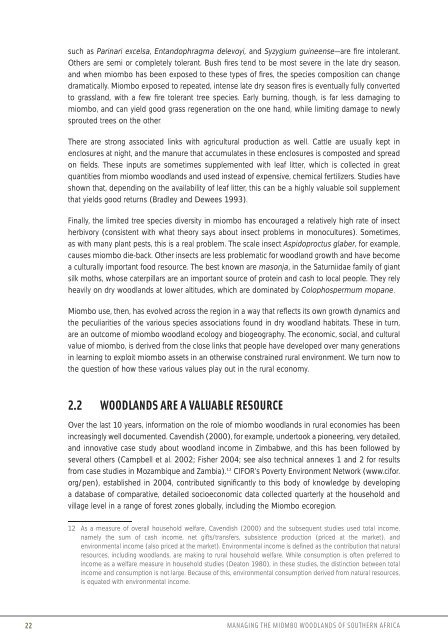Managing the Miombo Woodlands of Southern Africa - PROFOR
Managing the Miombo Woodlands of Southern Africa - PROFOR
Managing the Miombo Woodlands of Southern Africa - PROFOR
You also want an ePaper? Increase the reach of your titles
YUMPU automatically turns print PDFs into web optimized ePapers that Google loves.
such as Parinari excelsa, Entandophragma delevoyi, and Syzygium guineense—are fi re intolerant.<br />
O<strong>the</strong>rs are semi or completely tolerant. Bush fi res tend to be most severe in <strong>the</strong> late dry season,<br />
and when miombo has been exposed to <strong>the</strong>se types <strong>of</strong> fi res, <strong>the</strong> species composition can change<br />
dramatically. <strong>Miombo</strong> exposed to repeated, intense late dry season fi res is eventually fully converted<br />
to grassland, with a few fi re tolerant tree species. Early burning, though, is far less damaging to<br />
miombo, and can yield good grass regeneration on <strong>the</strong> one hand, while limiting damage to newly<br />
sprouted trees on <strong>the</strong> o<strong>the</strong>r.<br />
There are strong associated links with agricultural production as well. Cattle are usually kept in<br />
enclosures at night, and <strong>the</strong> manure that accumulates in <strong>the</strong>se enclosures is composted and spread<br />
on fi elds. These inputs are sometimes supplemented with leaf litter, which is collected in great<br />
quantities from miombo woodlands and used instead <strong>of</strong> expensive, chemical fertilizers. Studies have<br />
shown that, depending on <strong>the</strong> availability <strong>of</strong> leaf litter, this can be a highly valuable soil supplement<br />
that yields good returns (Bradley and Dewees 1993).<br />
Finally, <strong>the</strong> limited tree species diversity in miombo has encouraged a relatively high rate <strong>of</strong> insect<br />
herbivory (consistent with what <strong>the</strong>ory says about insect problems in monocultures). Sometimes,<br />
as with many plant pests, this is a real problem. The scale insect Aspidoproctus glaber, for example,<br />
causes miombo die-back. O<strong>the</strong>r insects are less problematic for woodland growth and have become<br />
a culturally important food resource. The best known are masonja, in <strong>the</strong> Saturniidae family <strong>of</strong> giant<br />
silk moths, whose caterpillars are an important source <strong>of</strong> protein and cash to local people. They rely<br />
heavily on dry woodlands at lower altitudes, which are dominated by Colophospermum mopane.<br />
<strong>Miombo</strong> use, <strong>the</strong>n, has evolved across <strong>the</strong> region in a way that refl ects its own growth dynamics and<br />
<strong>the</strong> peculiarities <strong>of</strong> <strong>the</strong> various species associations found in dry woodland habitats. These in turn,<br />
are an outcome <strong>of</strong> miombo woodland ecology and biogeography. The economic, social, and cultural<br />
value <strong>of</strong> miombo, is derived from <strong>the</strong> close links that people have developed over many generations<br />
in learning to exploit miombo assets in an o<strong>the</strong>rwise constrained rural environment. We turn now to<br />
<strong>the</strong> question <strong>of</strong> how <strong>the</strong>se various values play out in <strong>the</strong> rural economy.<br />
2.2 WOODLANDS ARE A VALUABLE RESOURCE<br />
Over <strong>the</strong> last 10 years, information on <strong>the</strong> role <strong>of</strong> miombo woodlands in rural economies has been<br />
increasingly well documented. Cavendish (2000), for example, undertook a pioneering, very detailed,<br />
and innovative case study about woodland income in Zimbabwe, and this has been followed by<br />
several o<strong>the</strong>rs (Campbell et al. 2002; Fisher 2004; see also technical annexes 1 and 2 for results<br />
from case studies in Mozambique and Zambia). 12 CIFOR’s Poverty Environment Network (www.cifor.<br />
org/pen), established in 2004, contributed signifi cantly to this body <strong>of</strong> knowledge by developing<br />
a database <strong>of</strong> comparative, detailed socioeconomic data collected quarterly at <strong>the</strong> household and<br />
village level in a range <strong>of</strong> forest zones globally, including <strong>the</strong> <strong>Miombo</strong> ecoregion.<br />
12 As a measure <strong>of</strong> overall household welfare, Cavendish (2000) and <strong>the</strong> subsequent studies used total income,<br />
namely <strong>the</strong> sum <strong>of</strong> cash income, net gifts/transfers, subsistence production (priced at <strong>the</strong> market), and<br />
environmental income (also priced at <strong>the</strong> market). Environmental income is defi ned as <strong>the</strong> contribution that natural<br />
resources, including woodlands, are making to rural household welfare. While consumption is <strong>of</strong>ten preferred to<br />
income as a welfare measure in household studies (Deaton 1980), in <strong>the</strong>se studies, <strong>the</strong> distinction between total<br />
income and consumption is not large. Because <strong>of</strong> this, environmental consumption derived from natural resources,<br />
is equated with environmental income.<br />
22 MANAGING THE MIOMBO WOODLANDS OF SOUTHERN AFRICA

















